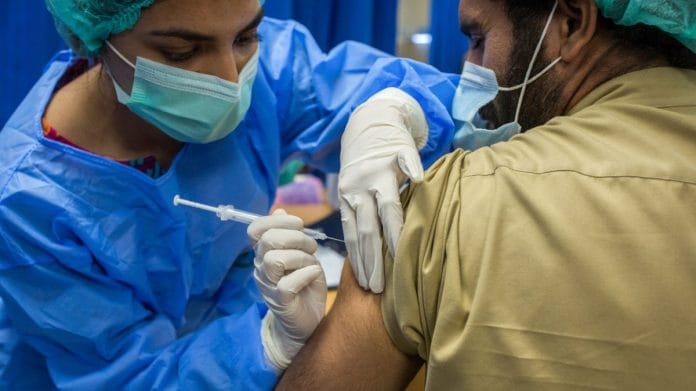Many fortuitous circumstances came to India’s aid during the Covid-19 pandemic. The fact that the disease came to the country a little late — giving doctors the time to understand it better — and the relatively young population ensured lower casualties, were the two major factors that worked in India’s favour. So India’s report card looked way better than the rest of the world.
But after months of steady decline, the disease seems to be on an upswing once more in several states. Against this backdrop, the Narendra Modi government’s decision to extend the vaccination drive to the elderly population could act as another lucky coincidence, helping India stay ahead of the curve. And that is why the cabinet’s decision to start Covid-19 vaccination for those aged 60 years and above, and those with co-morbidities between 45-60 years, is ThePrint’s Newsmaker of the Week.
The hesitancy headache…
Of the 16,577 new cases reported in the last 24 hours, 86.18 per cent are from six states alone — Maharashtra, Kerala, Punjab, Tamil Nadu, Karnataka and Gujarat. In a way, this is good news because India’s first brush with the vaccine, in course of giving the shot to healthcare and frontline workers, has come with a fair dose of hesitancy. It is a recognised fact in public health that receding fear of a disease acts as a major cause for vaccine hesitancy.
Till Friday, of the total three crore healthcare and frontline workers targeted, just 1.34 crore had been covered since the launch of the vaccination programme on 16 January. This is just a little over a third of the targeted population. Repeated pleas and even ‘threats’ from the government, that a registered person would not get their shots if they miss their turn unless they qualify in the age criteria, has failed to speed things up. Nine states and UTs have vaccinated less than 60 per cent of the registered healthcare workers (HCWs) and 13 states/UTs have vaccinated less than 40 per cent of registered frontline workers (FLW).
The fact that India is expanding the vaccine net to those aged 45 and above at a time when Maharashtra is tottering at the brink of another lockdown, several states have mandated travellers from some of the worst-hit states to carry RT-PCR negative certificates, and containment zones are returning (the hostel in Washim where 200 people tested positive), bodes well for the vaccine rollout. People will likely be more willing now to take the shot than they would have been perhaps a month or so ago when the pandemic had seemed almost on its way out.
That though may well be the only positive as the country embarks on a massive programme to vaccinate an estimated 27 crore people through registrations over a glitch-prone app (CoWin). The fact that one needs a smartphone to register is the first hurdle in a diverse country. It will by means be the last or the biggest challenge.
Also read: India’s Covid R value crosses 1 once again, Maharashtra, Punjab & Karnataka see increase too
…vs vaccine eagerness
The government may have a far bigger problem on its hands should the vaccine hesitancy of the first phase be replaced by an equal degree of vaccine eagerness in the general population and should certificates of comorbidities — diseases that make people more prone to worse Covid-19 outcomes pour in thick and fast. With the government announcing that a prescription from a registered medical practitioner would suffice, who is to vouch for the authenticity of the document, in a country where medical certificates for sick leaves are openly bought? Vaccine eagerness is a distinct possibility also because Prime Minister Narendra Modi and state chief ministers are expected to take their shots during this second phase. Modi’s iconic following could give public trust in Covid-19 vaccines a much needed boost.
However, when huge swathes of elderly and ailing population get the vaccine, the adverse events following immunisation (AEFI) may be a potential minefield. India has already seen 39 post-vaccination deaths and the official position is that none are “causally linked” to vaccinations.
But how the old and infirm react to the vaccines, which are usually tested on healthy volunteers, is a different proposition. Any untoward incident could require the firefighting skills of the entire government machinery, and even then, bring the pointer back to vaccine hesitancy.
Also read: Will convince Modi govt to bring back Pfizer vaccine, it will add value: CSIR chief Mande
The cost and communication
The apparent reluctance of the State’s communication machinery to part with actual information has been the hallmark of the Modi government’s pandemic communication; it continues to remain a problem. Three days from the launch of the expanded programme that will cover the elderly, the CoWin website is yet to open to the public and there is no statement on whether or not registrations will be possible before the launch date. There is no clarity either on whether private hospitals will get the vaccine for free, or the cost of each shot at such facilities, and most importantly, who will pay for any hospitalisation that may be required post-vaccination, especially in private hospitals.
The Modi government has already said that Pradhan Mantri Jan Arogya Yojana — the tertiary care arm of the NDA government’s flagship health programme Ayushman Bharat — will not cover Covid-19 vaccinations even though the private hospitals where vaccines will be given have to be empaneled either with the National Health Authority or the Central Government Health Scheme (CGHS). Will PMJAY or CGHS cover AEFI related health costs? We do not know.
Views are personal.






